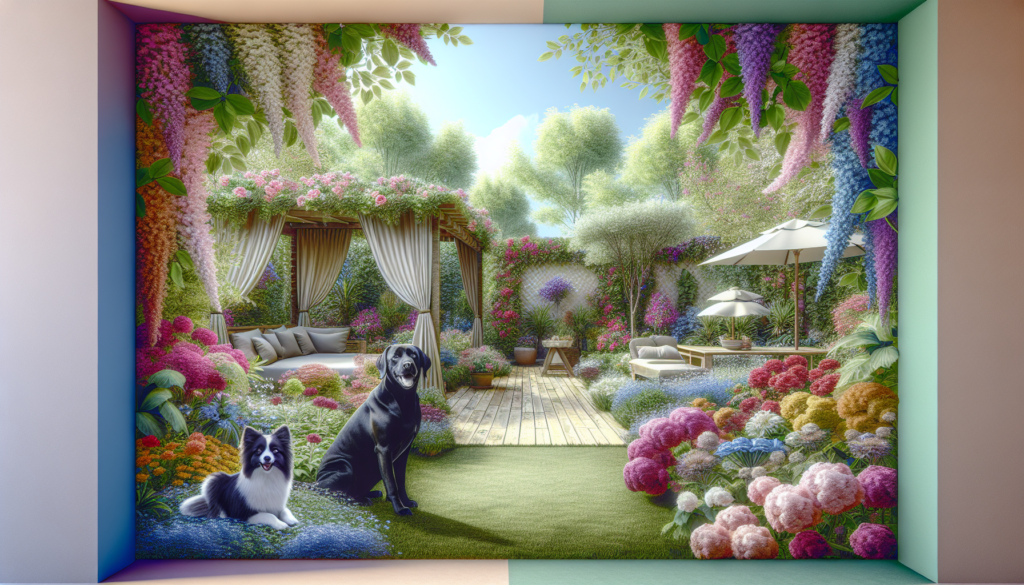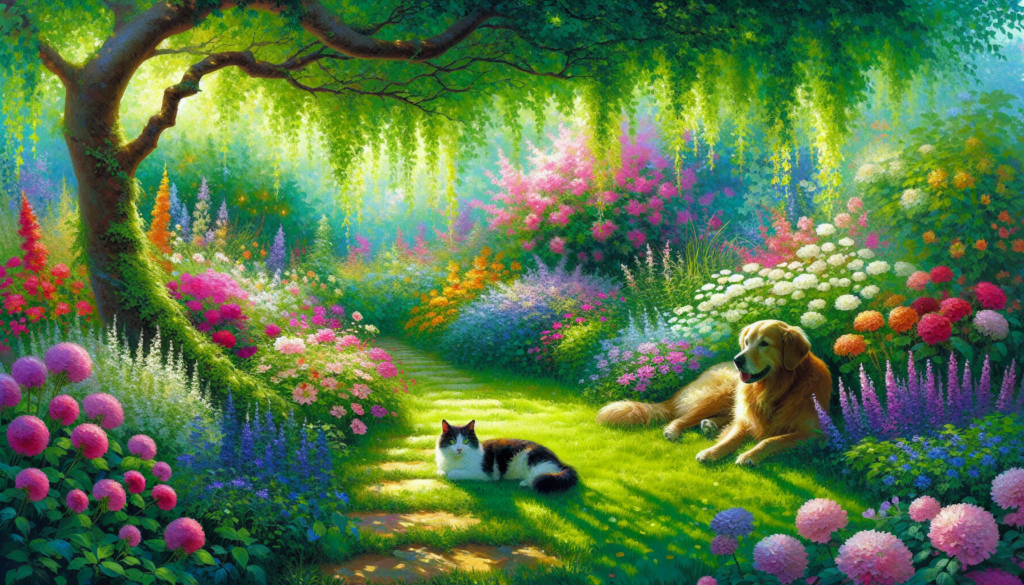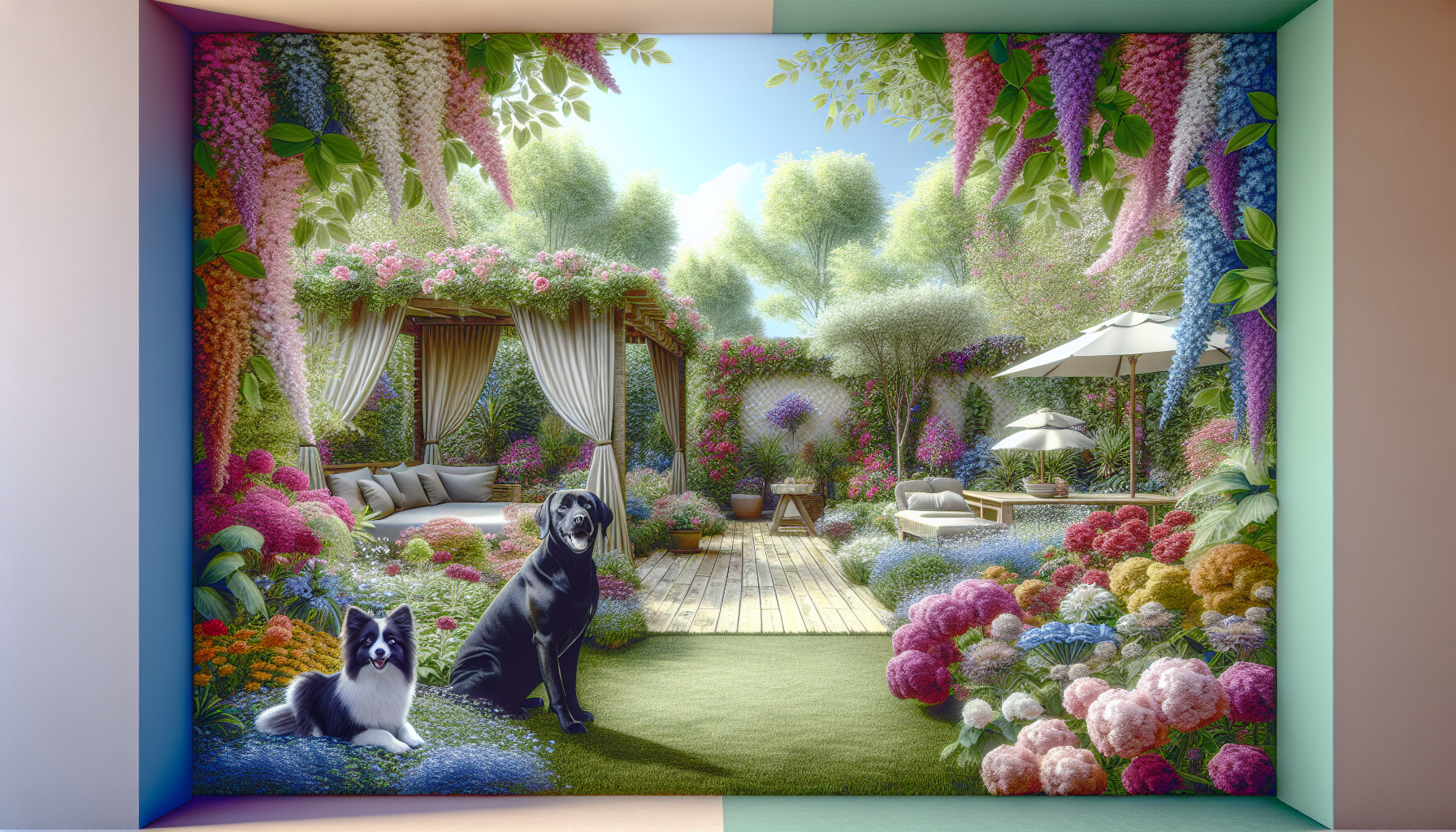Imagine stepping into your own personal oasis, surrounded by lush greenery and vibrant flowers. Picture your furry friend frolicking in the sunshine and exploring a safe, inviting space just for them. In this article, we will explore the art of creating a pet-friendly garden space, offering practical tips and creative ideas to ensure your outdoor sanctuary is not only aesthetically pleasing, but also a haven for your beloved pets. From selecting pet-safe plants to designing interactive play areas, get ready to transform your garden into a paradise both you and your furry companions will adore.
Designing with Safety in Mind
Designing a pet-friendly garden starts with prioritizing safety for your furry friends. This means carefully choosing plants that are non-toxic and safe for pets to be around. Certain plants, such as lilies and azaleas, can be harmful or even toxic to animals if ingested. Opt for pet-friendly plants like marigolds, sunflowers, and petunias, which are not only beautiful but also safe for your pets to be around. Before introducing any new plants to your garden, make sure to research their toxicity level to avoid any potential risks.
Creating secure boundaries is another essential aspect of designing a pet-friendly garden. Ensure that your fencing is secure and properly encloses your garden space. Choose fencing materials that are sturdy and can withstand the strength and curiosity of your pets. Additionally, consider adding barriers to specific areas within your garden to keep pets away from potential hazards, such as compost bins or delicate flower beds. Accessible but secure boundaries will give your pets the freedom to explore while keeping them safe within your garden space.
Eliminating toxic substances is crucial in creating a pet-friendly garden environment. While many garden products such as fertilizers, pesticides, and herbicides are necessary for maintaining a beautiful garden, it’s important to choose pet-safe alternatives. Look for organic and pet-friendly options when purchasing these products. Avoid using chemicals that can be harmful if ingested or cause skin irritation. Prioritize your pet’s well-being by opting for natural and non-toxic solutions that will still allow your garden to thrive.
Providing shaded areas is essential, especially during hot summer days when pets need a cool spot to relax. Incorporate shaded areas within your garden by strategically placing trees or installing a pergola or canopy. These shaded areas will not only protect your pets from the sun but also provide a cozy space for them to nap or enjoy the outdoors comfortably. Remember to have fresh water available in shaded areas to keep your pets hydrated and cool during the warmest months of the year.
Paving the Way for Paws
When it comes to creating a pet-friendly garden, the choice of paving materials is essential. Avoid materials like asphalt or concrete, as they can get extremely hot during summer months and potentially burn your pet’s paws. Instead, opt for pet-friendly materials like natural stone, brick, or gravel. These materials are cooler and more comfortable for your pets to walk on, ensuring their safety and comfort while exploring your garden.
Creating designated paths within your garden helps guide your pets and prevents them from trampling delicate plants or flower beds. Designate clear pathways using pavers, stepping stones, or gravel to define where your pets should walk. These paths will not only protect your garden but also serve as an adventure trail for your pets, keeping them engaged and entertained.
Another way to incorporate pet-friendly paving is by adding gravel or mulch areas. These materials not only create visual interest within your garden but also provide your pets with a comfortable spot to relax, play, or dig. Gravel or mulch areas also allow for proper drainage, reducing the risk of muddy paws and making it easier for you to clean up after your pets.
Stepping stones can serve as an element of fun and excitement for your pets. Install stepping stones strategically throughout your garden, creating a playful and interactive experience for your pets. They can hop from stone to stone, exploring different areas and adding a touch of charm to your garden design.

Creating a Digging Zone
For many pets, digging is an innate behavior that they enjoy. Instead of constantly trying to prevent this behavior, why not create a designated digging area where they can indulge in their natural instinct? By incorporating a designated digging zone into your garden design, you provide your pets with an outlet for their digging needs while simultaneously protecting your precious plants.
Choose an area in your garden where you don’t mind your pet digging, such as a corner or a less visible spot. Prepare the digging zone by digging out the soil or filling it with loose soil or sand, making it easier for your pets to dig. You can also add toys or treats to entice them to use the designated area. By providing them with a specific spot to dig, you can redirect their behavior and discourage them from digging in other areas of your garden.
Training your pet to use the digging zone is an essential part of creating a successful designated area. Whenever you catch your pet digging in an undesired location, gently redirect them to the designated area and reward them for using it. With consistency and positive reinforcement, your pet will learn to associate the designated digging zone with their digging needs.
Including Water Features
Water features can add a beautiful and soothing element to your garden, and they can also be enjoyed by your pets. When incorporating water features into your pet-friendly garden, it’s important to consider their safety and accessibility.
Adding a pet-friendly water fountain or pond can be a great addition to your garden. However, it’s essential to ensure that the water is clean and suitable for your pets to drink. Avoid using chlorine or other chemicals in the water, as these can be harmful to your pets. Instead, opt for natural filtration systems or use pet-friendly water additives to keep the water clean and safe.
If you have a pond or any large water feature, ensure that there are shallow areas where your pets can easily access and exit the water. This is especially important for smaller or older pets who may have difficulty swimming or climbing out of deep water. Adding rocks or steps within the water will provide them with a safe and comfortable way to enjoy the water.
Monitoring water quality is crucial to maintain a healthy environment for your pets. Regularly check the water pH levels and ensure that there is no algae growth or stagnant water. Keep the water feature clean by removing any debris or leaves that may accumulate. By maintaining proper water quality, you can ensure that your pets can safely enjoy the water feature without any health risks.

Designing Pet-friendly Structures
When designing your garden, it’s important to consider pet-friendly structures that will enhance their experience and provide them with shelter.
Building a pet-friendly fence is essential to keep your pets safe within your garden space. Ensure that the fence is sturdy and tall enough to prevent your pets from jumping over. Depending on your pet’s size and agility, you may need to consider additional measures, such as installing wire mesh along the bottom of the fence to prevent digging under.
A pet-friendly gate is equally important to allow easy access for both you and your pets. Consider installing a gate with a secure latch that your pets cannot easily open. If you have smaller pets, opt for a gate with smaller gaps to prevent them from squeezing through. The gate should be well-maintained and regularly inspected for any signs of wear or damage.
Creating shelters and hideouts within your garden provides your pets with a sense of security and a place to rest. Install pet-friendly shelters, such as doghouses or cat condos, where your pets can seek shade or take refuge during inclement weather. These shelters should be well-ventilated and insulated to ensure maximum comfort for your pets. You can also incorporate natural elements, such as shrubs or trees, to create natural hideouts that your pets can enjoy.
Incorporating pet-friendly seating areas allows both you and your pets to relax and enjoy your garden together. Choose outdoor furniture made from pet-friendly materials that are durable and easy to clean. Consider adding cushions or blankets for added comfort. By including pet-friendly seating, you create a cozy space for bonding with your pets while enjoying the beauty of your garden.
Choosing Pet-friendly Garden Accessories
When selecting garden accessories, it’s important to choose materials that are non-toxic and durable, ensuring the safety and longevity of your pet-friendly garden.
Opt for non-toxic and durable materials when choosing garden accessories. Avoid accessories made from chemicals or materials that can be harmful if ingested. Look for accessories made from pet-friendly materials such as wood, natural fibers, or non-toxic metals. These accessories will not only be safe for your pets but also add a touch of beauty to your garden.
Selecting toys and play structures specifically designed for pets will keep them engaged and entertained. Look for toys made from durable materials that can withstand rough play and chewing. Choose interactive toys that stimulate their minds and keep them physically active. Incorporating play structures, such as climbing trees or obstacle courses, can provide your pets with a playground within your garden.
Using pet-friendly pest control methods is crucial to protect your pets from harmful chemicals. Avoid using pesticides or insecticides that can be toxic to your pets. Opt for natural pest control methods, such as companion planting or introducing beneficial insects, to keep pests at bay. It’s also important to regularly inspect your garden for signs of pests and address any infestations promptly.
Providing waste disposal systems within your garden encourages proper waste management and hygiene. Install pet waste stations or designate specific areas for waste disposal. Make sure to regularly clean and remove waste from these areas to maintain a clean and odor-free garden. Consider using biodegradable waste bags or composting systems to minimize environmental impact.
Garden Layout for Pet Activities
Creating a well-planned garden layout ensures that you have designated spaces for various pet activities, promoting an active and engaging environment for your pets.
Open spaces are essential for pets to play and roam freely. Designate larger open areas within your garden where your pets can run, chase toys, and play games with you. This will allow them to release energy and stay healthy by engaging in physical activities.
Incorporating agility or obstacle courses within your garden adds a fun and challenging element for your pets. Install ramps, tunnels, and hurdles that your pets can navigate through, providing mental stimulation and improving their agility. These courses can be adjusted based on your pet’s size, age, and abilities.
Installing pet-friendly barriers is important to prevent your pets from accessing certain areas or plants that may be harmful to them or your garden. Use natural barriers such as hedges, low fences, or decorative plantings to define boundaries and guide your pets. These barriers should be visually appealing and blend seamlessly with your garden design.
Designating resting areas within your garden is equally important. Introduce cozy spots with comfortable bedding where your pets can take a break and relax. These resting areas can be designed under shade structures or nestled among foliage, providing your pets with a tranquil space to recharge and enjoy the serenity of your garden.
Addressing Urine Spots and Hygiene
Dealing with urine spots and maintaining proper hygiene in your pet-friendly garden is essential to keep it clean and healthy.
Choosing pet-friendly turf or artificial grass is an effective solution to minimize the impact of urine spots in your garden. These alternatives are designed to withstand frequent pet usage and are easy to clean. Look for artificial grass or turf specifically designed for pets, as they are typically made with materials that prevent odors and allow for proper drainage.
Creating adequate drainage is crucial to prevent urine spots from becoming an issue. Ensure that your garden has proper drainage systems in place, allowing urine to flow away from your desired areas. This will help prevent the accumulation of urine, reducing the risk of odors and unsightly spots in your garden.
Using odor-neutralizing products can help eliminate any lingering smells caused by pet waste. Choose pet-friendly and natural odor-neutralizing sprays or granules that are safe for both your pets and the environment. Regularly apply these products in areas prone to urine spots or where pet waste is present.
Establishing a regular cleanup routine is essential for maintaining a clean and hygienic pet-friendly garden. Regularly remove any solid waste and dispose of it properly. Use a hose or water sprayer to dilute urine spots and rinse them away. Consider using pet-safe disinfectants or cleaners to sanitize areas where pet waste has been present. By establishing a routine, you can ensure that your garden remains fresh and clean for both you and your pets to enjoy.
Maintaining a Pet-friendly Garden
Once your pet-friendly garden is established, regular maintenance is critical to ensure its longevity and your pet’s continued enjoyment.
Regularly inspecting your garden for potential hazards is essential for the safety of your pets. Look for loose or damaged fencing, sharp objects, or poisonous plants. Identify and address any potential hazards immediately to prevent accidents or harm to your pets.
Trimming foliage and removing debris is crucial to keep your garden neat and safe for your pets. Regularly trim any overgrown plants or tree branches that may pose a risk to your pets. Sweep and remove fallen leaves, twigs, or any other debris that could become a potential hazard or cause your pets discomfort.
Replenishing water and food stations is important to keep your pets hydrated and well-fed during their time in the garden. Ensure that water bowls are filled with fresh, clean water and have multiple stations throughout your garden. If you provide food for your pets outside, make sure it is in secure containers and not left unattended for extended periods.
Providing regular exercise and stimulation is key to keeping your pets happy and healthy. Take the time to play with your pets in the garden, engage them in interactive activities, and provide them with toys or puzzles that stimulate their minds. Regular exercise and mental stimulation will not only keep your pets physically fit but also strengthen the bond between you and your furry friends.
Encouraging Wildlife Safety
While designing a pet-friendly garden, it’s important to also consider the safety and well-being of other creatures that share the space with your pets.
Avoiding toxic plants for animals is crucial to protect the wildlife that may visit your garden. Research which plants, flowers, or berries can be toxic to wildlife and avoid incorporating them into your garden design. Opt for native plants that are beneficial and safe for wildlife, attracting birds, butterflies, and other pollinators.
Creating separate feeding areas for wildlife encourages harmony between your pets and the visiting creatures. Install bird feeders or squirrel feeding stations away from areas where your pets roam freely. These separate feeding areas provide wildlife with their own designated spot, reducing competition and potential conflicts with your pets.
Minimizing the use of pesticides is important to protect the ecosystem within your garden. Pesticides can be harmful not only to your pets but also to beneficial insects, birds, and other wildlife. Opt for natural pest control methods, such as companion planting or introducing beneficial insects, to maintain a balance in your garden ecosystem.
Providing nesting options for birds and other small animals is a wonderful way to support wildlife in your garden. Install birdhouses, nesting boxes, or create natural nesting spots by leaving brush piles or dead trees. These nesting options provide shelter and breeding spaces for wildlife, enhancing the diversity and ecological value of your garden.
By creating a pet-friendly garden space that considers the safety, comfort, and enjoyment of your pets, you can create a harmonious and engaging environment. With proper planning, design, and maintenance, your garden will not only be a beautiful sanctuary for you but also a haven that your pets can explore, play, and relax in safely. Remember to regularly assess and adapt your garden to cater to the changing needs of your pets, ensuring that it remains a cherished space for all.

